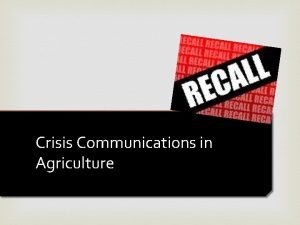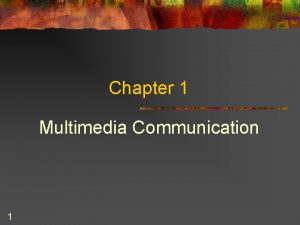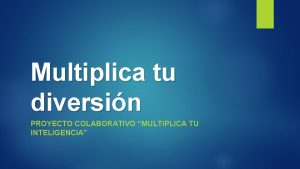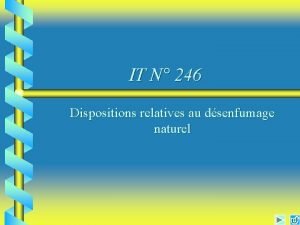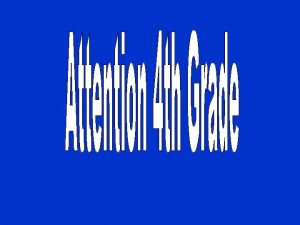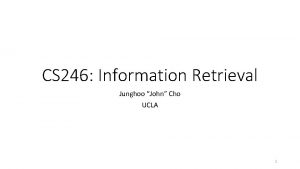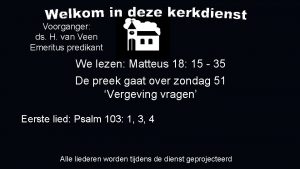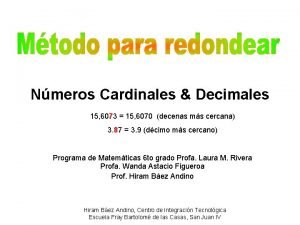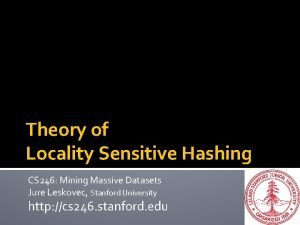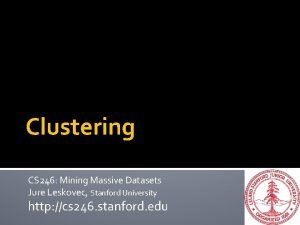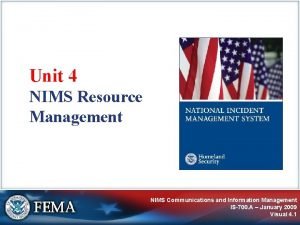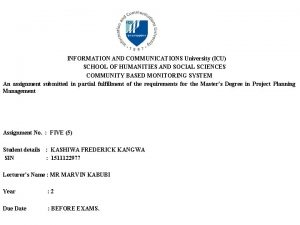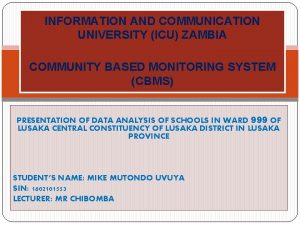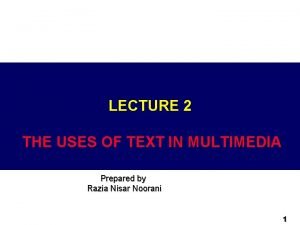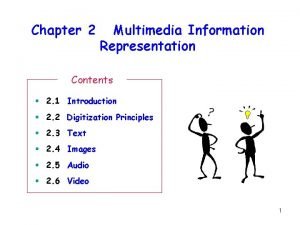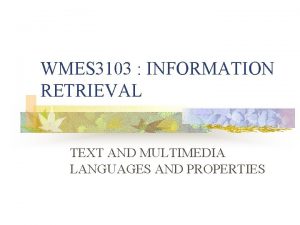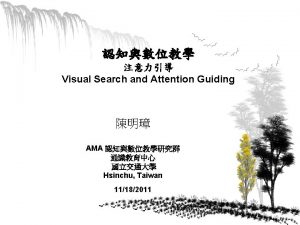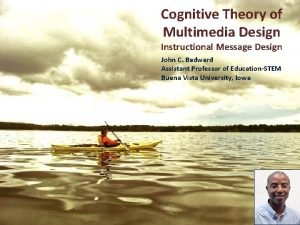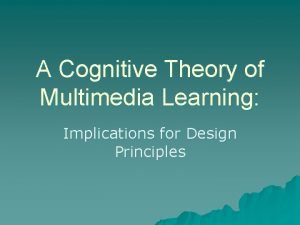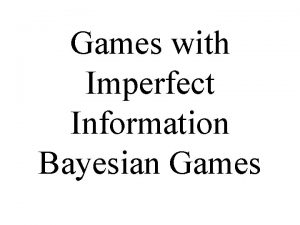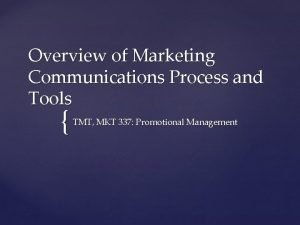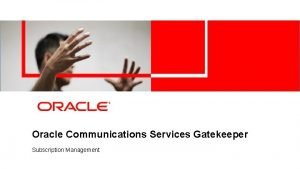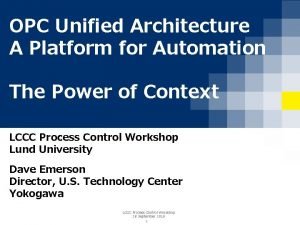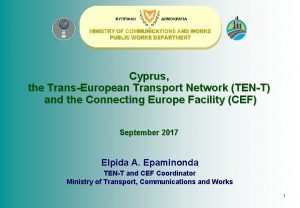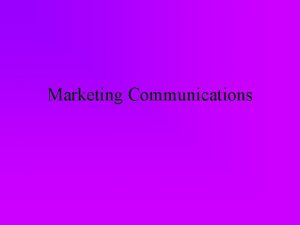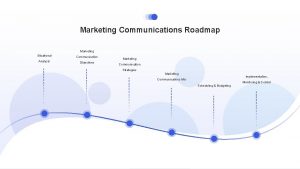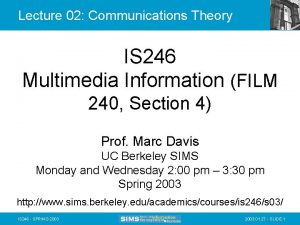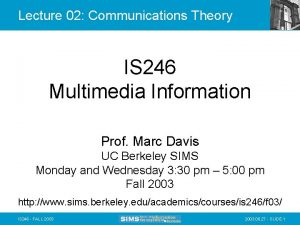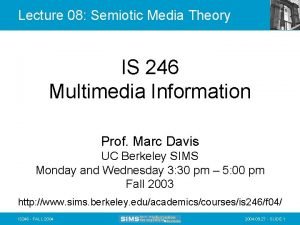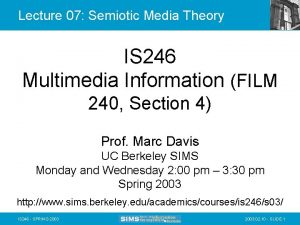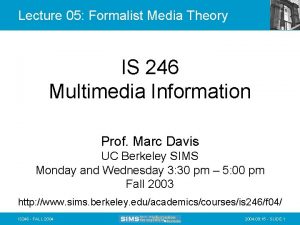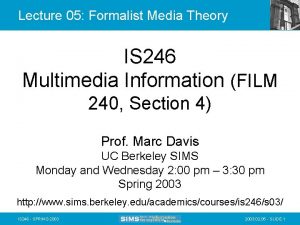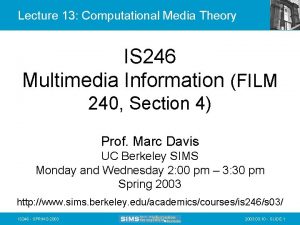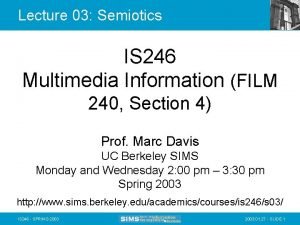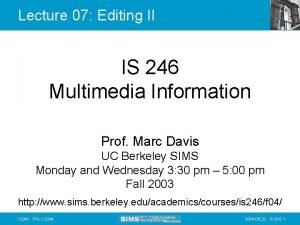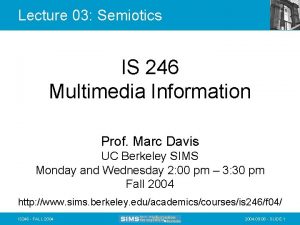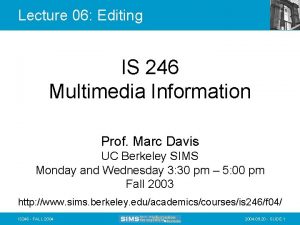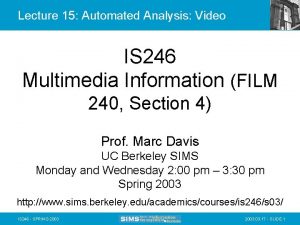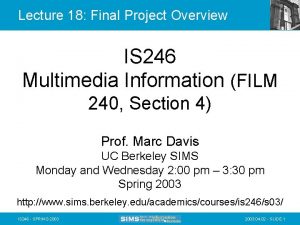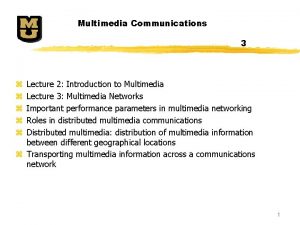Lecture 02 Communications Theory IS 246 Multimedia Information
















































- Slides: 48

Lecture 02: Communications Theory IS 246 Multimedia Information Prof. Marc Davis UC Berkeley SIMS Monday and Wednesday 2: 00 pm – 3: 30 pm Spring 2003 http: //www. sims. berkeley. edu/academics/courses/is 246/s 03/ IS 246 - FALL 2004. 09. 01 - SLIDE 1

Today’s Agenda • Review of Last Time • Why Study Communication Theory? • Towards a New Understanding of Communication – Reddy on The Conduit Metaphor – Iser on The Reading Process – Barthes on “Author” and “Text” – Discussion Questions • Action Items for Next Time IS 246 - FALL 2004. 09. 01 - SLIDE 2

Today’s Agenda • Review of Last Time • Why Study Communication Theory? • Towards a New Understanding of Communication – Reddy on The Conduit Metaphor – Iser on The Reading Process – Barthes on “Author” and “Text” – Discussion Questions • Action Items for Next Time IS 246 - FALL 2004. 09. 01 - SLIDE 3

Purchase Course Textbooks • David Bordwell and Kristin Thompson. Film Art: An Introduction. 7 th Edition. Mc. Graw Hill, New York, 2004. – Web Site • http: //highered. mcgrawhill. com/sites/00724845 51/information_center_ view 0/ – Special Edition with CD-ROM • ISBN 0072975687 IS 246 - FALL 2004. 09. 01 - SLIDE 4

Course Textbooks • W. Daniel Hillis. The Pattern on the Stone: The Simple Ideas That Make Computers Work. Perseus Books Group, New York, 1999. – Web Site • http: //www. perseusbook sgroup. com/perseus-cgi -bin/display/0 -46502596 -X IS 246 - FALL 2004. 09. 01 - SLIDE 5

Goals of the Course • Acquire theoretical and practical foundations to analyze, design, and produce multimedia information systems – Media theory – Media practice – Current and future media systems and applications • Learn to apply media theory to media design • Gain further experience in project-based learning and teamwork • Develop an enduring framework and methodology for media analysis and design IS 246 - FALL 2004. 09. 01 - SLIDE 6

Course Overview • Course phases – Theoretical and practical foundations – Current issues and methods – The future of multimedia • Course assignments – Theory application – Short media production – Final project IS 246 - FALL 2004. 09. 01 - SLIDE 7

The Media Problem • Vastly more media will be produced • Without ways to manage it (metadata creation and use) we lose the advantages of digital media • Most current approaches are insufficient are perhaps misguided • Great opportunity for innovation and invention • Need interdisciplinary approaches to the problem IS 246 - FALL 2004. 09. 01 - SLIDE 8

Today’s Agenda • Review of Last Time • Why Study Communication Theory? • Towards a New Understanding of Communication – Reddy on The Conduit Metaphor – Iser on The Reading Process – Barthes on “Author” and “Text” – Discussion Questions • Action Items for Next Time IS 246 - FALL 2004. 09. 01 - SLIDE 9

Communication Theory • Encompasses a vast array of disciplines – Mass communications, literary and media theory, rhetoric, sociology, psychology, linguistics, law, cognitive science, information science, engineering, etc. • Questions – What and how we communicate – Why we communicate – What happens when communication “works” and when it doesn’t – How to improve communication IS 246 - FALL 2004. 09. 01 - SLIDE 10

Why Study Communication Theory? • Our understanding of what, how, and why we communicate informs our – Theory of media and practice of media production – Analysis, design, and evaluation of multimedia information system and applications – How we work together in teams – How we read texts and talk with one another in this course – Law and public policy IS 246 - FALL 2004. 09. 01 - SLIDE 11

Etymology of “Communication” • Communication - c. 1384, from O. Fr. communicacion, from L. communicationem (nom. communicatio), from communicare "to impart, share, " lit. "to make common, " from communis (see common). • Common - 13 c. , from O. Fr. comun, from L. communis "shared by all or many, " from L. com- "together" + munia "public duties, " those related to munia "office. " Alternate etymology is that Fr. got it from P. Gmc. *gamainiz (cf. O. E. gemæne), from PIE *kom-moini "shared by all, " from base *moi-, *mei- "change, exchange. " • Remuneration - c. 1400, from L. remunerationem, from remunerari "to reward, " from re- "back" + munerari "to give, " from munus (gen. muneris) "gift, office, duty. " Remunerative is from 1677. IS 246 - FALL 2004. 09. 01 - SLIDE 12

What and How Do We Communicate? • What “gifts” do we give each other? • What do we do with these gifts? • How does this gift exchange bring us together (or not)? IS 246 - FALL 2004. 09. 01 - SLIDE 13

Today’s Agenda • Review of Last Time • Why Study Communication Theory? • Towards a New Understanding of Communication – Reddy on The Conduit Metaphor – Iser on The Reading Process – Barthes on “Author” and “Text” – Discussion Questions • Action Items for Next Time IS 246 - FALL 2004. 09. 01 - SLIDE 14

Beyond the Conduit Metaphor • Reddy – Identification of the Conduit Metaphor – Suggestion of alternate Toolmakers’ Paradigm • Iser – The reading process as a primary example of the Toolmakers’ Paradigm – Phenomenology of the reading process • Barthes – New conceptions of “author” and “text” IS 246 - FALL 2004. 09. 01 - SLIDE 15

Today’s Agenda • Review of Last Time • Why Study Communication Theory? • Towards a New Understanding of Communication – Reddy on The Conduit Metaphor – Iser on The Reading Process – Barthes on “Author” and “Text” – Discussion Questions • Action Items for Next Time IS 246 - FALL 2004. 09. 01 - SLIDE 16

Metaphor of/in Communication • • • It's hard to get that idea across to him. I gave you that idea. It's difficult to put my ideas into words. The meaning is right there in the words. His words carry little meaning. That's not what I got out of what he said. IS 246 - FALL 2004. 09. 01 - SLIDE 17

The Conduit Metaphor • Language functions like a conduit, transferring thoughts bodily from one person to another • In writing and speaking, people insert their thoughts or feelings in the words • Words accomplish the transfer by containing the thoughts or feelings and conveying them to others • In listening or reading, people extract the thoughts and feelings once again from the words IS 246 - FALL 2004. 09. 01 - SLIDE 18

Conduit Metaphor: Minor Frameworks • Thoughts and feelings are ejected by speaking or writing into an external “idea space” • Thoughts and feelings are reified in this external space, so they exist independent of any need for living beings to think or feel them • These reified thoughts and feelings may, or may not, find their way back into the heads of living humans IS 246 - FALL 2004. 09. 01 - SLIDE 19

Toolmakers’ Paradigm IS 246 - FALL 2004. 09. 01 - SLIDE 20

Comparing Models • Conduit Metaphor – Repertoire Members (i. e. , perceptions, thoughts, or feelings) can migrate from one mind to another – Communication is a largely effort free act of unpacking the meaning in words (i. e. , the sender’s RMs in the Signals) – Communication does not involve the RMs of the receiver of the message IS 246 - FALL 2004 • Toolmakers Paradigm – Only Signals can pass between human beings, not RMs – Communication requires active engagement of both parties and often breaks down and needs repair – The meanings of signals are not contained within them, but made out of the constructive interaction between the signals and the RMs of the receiver 2004. 09. 01 - SLIDE 21

Semantic Pathology • Semantic Pathology – “Whenever two or more incompatible senses capable of figuring meaningfully in the same context develop around the same name” • Example – “This text is confusing. ” • Text(1) = The layout/font of the text is confusing. • Text(2) = The argument of the text is confusing. • Question: Where is Text(2)? IS 246 - FALL 2004. 09. 01 - SLIDE 22

Today’s Agenda • Review of Last Time • Why Study Communication Theory? • Towards a New Understanding of Communication – Reddy on The Conduit Metaphor – Iser on The Reading Process – Barthes on “Author” and “Text” – Discussion Questions • Action Items for Next Time IS 246 - FALL 2004. 09. 01 - SLIDE 23

Phenomenology of Experience • Computational model of time – Linear, discrete model of time as series of instants • Phenomenology of time – Anticipation of what will be – Retrospection of what has been IS 246 - FALL 2004. 09. 01 - SLIDE 24

Iser on the Literary Work • Literary work has two poles – Artistic • Text created by the author • Reddy’s signals – Text (1) • Metaphor of “stars” – Esthetic • Realization accomplished by the reader • Reddy’s Repertoire Members – Text (2) • Metaphor of “constellations” • Literary work comes to life in the interaction between text and reader – Virtual dimension – Gaps IS 246 - FALL 2004. 09. 01 - SLIDE 25

Iser on the Reading Process • Phenomenology of reading process similar to phenomenology of perception – Anticipation – Retrospection – Gestalt – Illusion-building/Illusion-breaking • Interaction with repertoire (familiar) • Alien associations (unfamiliar) • Text(1) and Text(2) IS 246 - FALL 2004. 09. 01 - SLIDE 26

Today’s Agenda • Review of Last Time • Why Study Communication Theory? • Towards a New Understanding of Communication – Reddy on The Conduit Metaphor – Iser on The Reading Process – Barthes on “Author” and “Text” – Discussion Questions • Action Items for Next Time IS 246 - FALL 2004. 09. 01 - SLIDE 27

Roland Barthes • Death of the Author – Who is the “I” that writes? – The reader constructs the author by means of the text • From Work to Text – Method: “The text is experienced only in an activity of production. ” – Plurality: “The text is plural. ” – Filiation: The author returns to his/her text as a guest – Text is a social space which coincides only with a practice of writing IS 246 - FALL 2004. 09. 01 - SLIDE 28

Today’s Agenda • Review of Last Time • Why Study Communication Theory? • Towards a New Understanding of Communication – Reddy on The Conduit Metaphor – Iser on The Reading Process – Barthes on “Author” and “Text” – Discussion Questions • Action Items for Next Time IS 246 - FALL 2004. 09. 01 - SLIDE 29

Discussion Questions (Reddy) • Reddy “The Conduit Metaphor” (Brooke Maury) – In Reddy’s ‘conduit metaphor, ’ words are envisioned as packages of information transmitted from one person to another. The role of the sender and receiver is mainly to package and unpackage the ‘content’ of the words they are sending and receiving. Is this really a useful metaphor for human communication? IS 246 - FALL 2004. 09. 01 - SLIDE 30

Discussion Questions (Reddy) • Reddy “The Conduit Metaphor” (Brooke Maury) – The toolmaker’s paradigm, wherein actors must ‘work’ hard and engage in ongoing negotiation to gain a clearer understanding of ‘instructions’ they have received, seems to better simulate the communication process, and takes into account context and many of the nuances of communication lacking in the conduit analogy (as discussed below). Which analogy is a closer approximation of the communication process? Is the conduit metaphor a straw man, valuable only as a means to illustrate the intricate semantics of communication? IS 246 - FALL 2004. 09. 01 - SLIDE 31

Discussion Questions (Reddy) • Reddy “The Conduit Metaphor” (Brooke Maury) – The conduit metaphor seems to ignore or conflict with the concept of ‘information feedback’ and Goffman’s assertion that people (and animals) engage in constant ‘impression management’ and unintentionally give-off information about their ‘meaning’ that can shed light on their explicit ‘giving’ of information. Moreover, this metaphor suggests that context has no role in communication. If all we are doing as ‘receivers’ of information is unpacking words to reveal their ‘content’ or meaning, then the fact that the sender was crying or yelling when she sent the words would have no value. Is the conduit metaphor a gross over-simplification of the communication process? Does is leave out critical details? IS 246 - FALL 2004. 09. 01 - SLIDE 32

Discussion Questions (Reddy) • Reddy “The Conduit Metaphor” (Brooke Maury) – Reddy illustrates his conduit metaphor by citing several common phrases in the English language, and his analysis of communication is heavily focused on written texts (e. g. poems, books, etc. ). Is the conduit metaphor useful in studying communication in other languages? What about languages in which the written text is symbolic (i. e. Chinese, Japanese, Heiroglyphics)? What about computer language and communication? Is the conduit metaphor useful in understanding face-to-face interaction, the visual image or film? IS 246 - FALL 2004. 09. 01 - SLIDE 33

Discussion Questions (Reddy) • Reddy “The Conduit Metaphor” (Brooke Maury) – Reddy suggests that ‘we do not preserve ideas by building libraries and recording voices. The only way to preserve culture is to train people the rebuild it, to “regrow” it… within themselves’ (p. 187). Yet a library often contains large amounts of feedback and metadata about a specific piece of culture. For example a library might contain an original work by Aristotle in the ‘original text’ and translated texts, as well as an array of history books describing Greece in Aristotle’s time, responses from Aristotle’s peers and students, as well analyses from scholars of philosophy. To put it simply, libraries may contain sufficient (if ‘impenetrable’) metadata about a particular element of culture to achieve a certain degree of posterity. If there is enough metadata about the ‘content’ being transmitted, is the problem of the conduit metaphor solved? IS 246 - FALL 2004. 09. 01 - SLIDE 34

Discussion Questions (Reddy) • Reddy “The Conduit Metaphor” (Prof. Davis) – How can an implicit theory of communication affect our analysis and design of multimedia information systems? – What are some examples of multimedia information systems that embody the Conduit Metaphor or the Toolmakers’ Paradigm theory of communication? How might they be redesigned? IS 246 - FALL 2004. 09. 01 - SLIDE 35

Discussion Questions (Iser) • Iser “The Reading Process” (Jeff Heer) – What is phenomenology? What presuppositions should we expect in this piece? (And are they met or are they negated? ) – What does Iser mean by the following terms or contrasts: • • • IS 246 - FALL 2004 written / unwritten text configurative meaning illusion-forming / illusion-breaking anticipation and retrospection continual modification evocation and subsequent negation of the familiar 2004. 09. 01 - SLIDE 36

Discussion Questions (Iser) • Iser “The Reading Process” (Jeff Heer) – What is a literary gestalt? How is it created? Why the reliance on visual metaphor? (Is this avoidable or inevitable? ) – Do what degree do we see the conduit metaphor at work in Iser's writing, despite his "recreationist" stance? What effect, if any, does this have on his "message"? IS 246 - FALL 2004. 09. 01 - SLIDE 37

Discussion Questions (Iser) • Iser “The Reading Process” (Jeff Heer) – If through reading a reader constructs "a reality different from his [her] own", what is the nature and constituents of this construction? (e. g. is it different from his own, yet constructed from his own? an intellectual bricolage? ) IS 246 - FALL 2004. 09. 01 - SLIDE 38

Discussion Questions (Iser) • Iser “The Reading Process” (Jeff Heer) – Is there an inherent value system at play here with respect to conscious versus unconscious recreative acts? (This has echoes of art criticism, such as art vs. non-art, or the avantgarde vs. kitsch. ) If so, should we challenge that system? IS 246 - FALL 2004. 09. 01 - SLIDE 39

Discussion Questions (Barthes) • Barthes “The Death of the Author” (Rebecca Shapley) – Describe the Author? What/who is said to be dying? – How does the concept of literature as an author-free performance-in-the-moment, perhaps captured in static form, translate to other forms of art? Painting, movies, music? Does this transfer support or complexify thesis of the essay? IS 246 - FALL 2004. 09. 01 - SLIDE 40

Discussion Questions (Barthes) • Barthes “The Death of the Author” (Rebecca Shapley) – Do you know anyone or have yourself written a published work? If the role of Author is not allowed, what role is left for the person(s) who take the time to write, edit, review, revise literary works? How do you feel about that? IS 246 - FALL 2004. 09. 01 - SLIDE 41

Discussion Questions (Barthes) • Barthes “The Death of the Author” (Rebecca Shapley) – If a particular person is good at generating text or artwork that is said to be “good”, how would we explain the repeated success, given the perspective of the essay? That is, does the death of the Author still provide for some assessment of quality in literature? How? IS 246 - FALL 2004. 09. 01 - SLIDE 42

Discussion Questions (Barthes) • Barthes “The Death of the Author” (Rebecca Shapley) – Building on Reddy’s comments about the importance of people educated to interact meaningfully with cultural objects (as opposed to simply storing them), does the quality of a literary work change with the readership? Take for example a book by Zora Neale Hurston, a black woman whose work was obviously not part of the white cannon of literature at the time she wrote it. Since then, her work has been appreciated an enthusiastic readership has developed; she is now considered an important writer. Does Barthes’ essay imply that the quality of the work has therefore changed? If so, what implications does this have for information management? IS 246 - FALL 2004. 09. 01 - SLIDE 43

Discussion Questions (Barthes) • Barthes “From Work to Text” (Sarah Ellinger) – Barthes comments, “The reduction of reading to a consumption is clearly responsible for the ‘boredom’ experienced by many in the face of the modern (unreadable) text. . . To be bored means that one cannot produce the text, ” (163). But only one page earlier he suggests that “The Text (if only by its frequent ‘unreadability’) decants the work (the work permitting) from its consumption and gathers it up as play, activity, production, practice, ” (162). When is a work unreadable as a text? And how might that apply to multimedia works? IS 246 - FALL 2004. 09. 01 - SLIDE 44

Discussion Questions (Barthes) • Barthes “From Work to Text” (Sarah Ellinger) – Barthes claims that it is one of the “’social’ functions” of the Text to pose problems of classification (157). What does that mean and what are its implications for metadata and organization? He also says that “The metaphor of the text is that of the network. ” (161). What are some approaches to organizing something best represented as a network rather than a point? And should we be aiming to organize the work or the Text? IS 246 - FALL 2004. 09. 01 - SLIDE 45

Today’s Agenda • Review of Last Time • Why Study Communication Theory? • Towards a New Understanding of Communication – Reddy on The Conduit Metaphor – Iser on The Reading Process – Barthes on “Author” and “Text” – Discussion Questions • Action Items for Next Time IS 246 - FALL 2004. 09. 01 - SLIDE 46

Sign Up for Office Hours • Wednesday, September 8 – 4: 00 pm – 6: 00 pm • Tuesday, September 14 – 2: 00 pm – 4: 00 pm • 314 South Hall IS 246 - FALL 2004. 09. 01 - SLIDE 47

Readings for Next Time • Wednesday 09/08 – Ferdinand de Saussure “Course in General Linguistics” (Gokce, Nick, Alison) IS 246 - FALL 2004. 09. 01 - SLIDE 48
 Crisis communication lecture
Crisis communication lecture Multimedia communications definition
Multimedia communications definition 01:640:244 lecture notes - lecture 15: plat, idah, farad
01:640:244 lecture notes - lecture 15: plat, idah, farad En un zoológico hay 246 aves
En un zoológico hay 246 aves It 246
It 246 Afman 10-246
Afman 10-246 Mining of massive datasets stanford
Mining of massive datasets stanford Write the highlighted digits place and value 567
Write the highlighted digits place and value 567 Junghoo cho ucla
Junghoo cho ucla Ada easd consensus
Ada easd consensus Psalm 246
Psalm 246 Redondear al dolar mas cercano
Redondear al dolar mas cercano Extendible hashing visualization
Extendible hashing visualization Round 246 to the nearest ten
Round 246 to the nearest ten Cs 246 stanford
Cs 246 stanford Multimedia becomes interactive multimedia when
Multimedia becomes interactive multimedia when Linear and non linear multimedia
Linear and non linear multimedia Csc253
Csc253 Esa multimedia.esa.int./multimedia/virtual-tour-iss
Esa multimedia.esa.int./multimedia/virtual-tour-iss Track and report nims
Track and report nims List of lecturers at icu zambia
List of lecturers at icu zambia Information and communication university
Information and communication university Unified health management information system
Unified health management information system Natural language processing nlp - theory lecture
Natural language processing nlp - theory lecture Bayesian decision theory lecture notes
Bayesian decision theory lecture notes Sargur srihari
Sargur srihari Natural language processing lecture notes
Natural language processing lecture notes Text in multimedia application
Text in multimedia application Digitization principles in multimedia
Digitization principles in multimedia Multimedia information retrieval in irs
Multimedia information retrieval in irs Cognitive theory of multimedia learning
Cognitive theory of multimedia learning Instructional message design
Instructional message design Cognitive theory of multimedia learning
Cognitive theory of multimedia learning Complete vs perfect information
Complete vs perfect information Crisis communication working group
Crisis communication working group Teledrop
Teledrop Means of telecommunication
Means of telecommunication 113-com-1022 powerpoint
113-com-1022 powerpoint Perform voice communications blc
Perform voice communications blc Communications mix
Communications mix Subscription management oracle
Subscription management oracle Sipfoundry
Sipfoundry Open platform communications unified architecture
Open platform communications unified architecture Who are puma unified communications
Who are puma unified communications Public works department cyprus
Public works department cyprus Communications system toolbox
Communications system toolbox Unset message aida
Unset message aida Objectives of marketing communication
Objectives of marketing communication Push pull profile strategies marketing communications
Push pull profile strategies marketing communications
